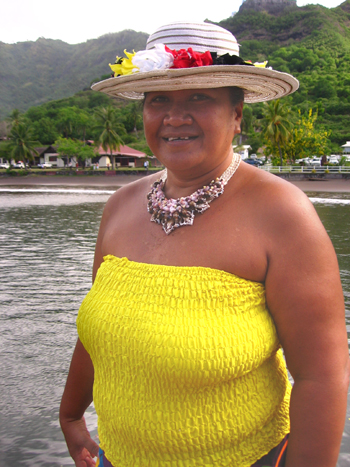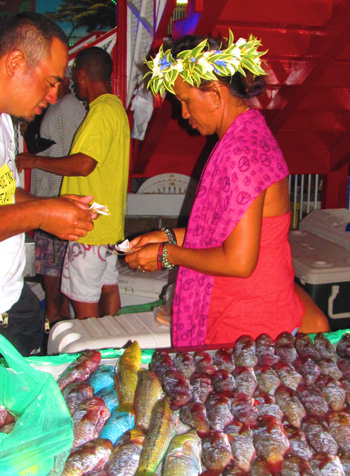|
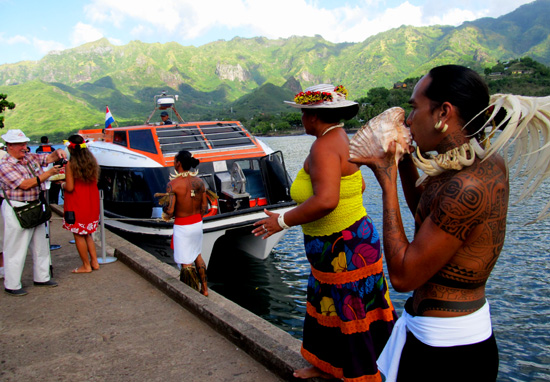


Our plan was to go out snorkeling with a resident pod of whales but,
even though we were on the first tender, the dive boat had left by
the time we got there. The dive shop also sold pareos and tropical
dresses. We were directed to an Australian who was willing to take
the 4 of us out, but by then the time constraints made it
impractical. We took the next tender back to the ship, dropped
our snorkel gear and headed out again prepared for walking.

Next to the dive shop was a snack bar with wi-fi
behind the wall of ripening bananas. I brought my computer in my
backpack for the walk and then I'd check my email, etc. 
Several pair of fairy terns circled around the area. This was taken
from the tender. 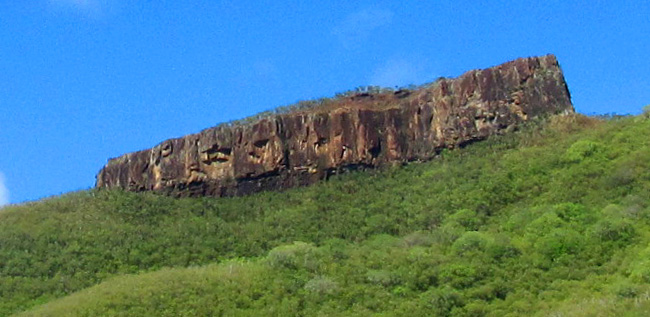
The backbone of the mountain was exposed here.


There were quite a few live-aboard sailboats visiting this island.
Once we came ashore again, we began our walk next to the tender dock
where locals were cleaning the catch of the day and throwing the
guts and waste into the water.


Some carved wood and tropical fabrics were offered for sale on tables
surrounding a square with this interesting tiki family.

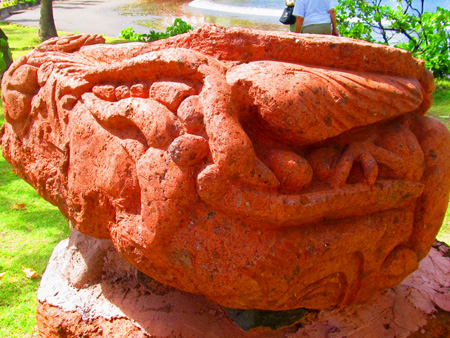
A nice variety of tikis and native carvings were arranged along the waterfront.


We interrupted our shoreline stroll to exchange some money into the
local currency, which would be used on the next 2 stops as well. We
liked how the bank sign made it look like it was on the edge of the
jungle. We also stopped to photograph this tethered bull in a
riverbed near the shoreline.


We liked the old gnarly trees.


As we crossed the river and continued down the shoreline, there was
an elevated stone platform with more sculptures, some of which
were reminiscent of Easter Island.

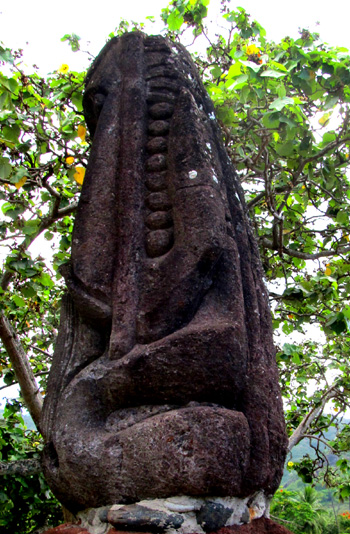


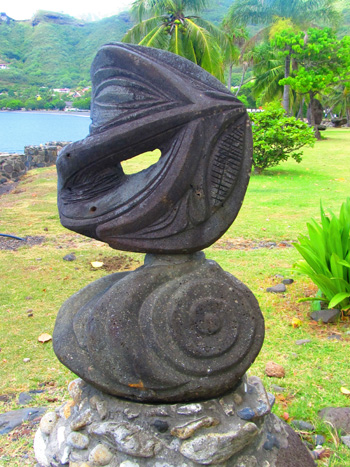

This sculpture seemed almost Picasso-like and was interesting on all
sides.

A meeting house tiki in front of the thatched meeting house was at
the end of the raised area.


The meeting house supports were carved into different images.


An ancient basin carved into a rock is the last tiki and then it's down this
beach...
 
Still life arrangements on the beach. The dark sand is from the
volcanic basalt. Coral is also worn down from being tossed on the
beach with the rocks.
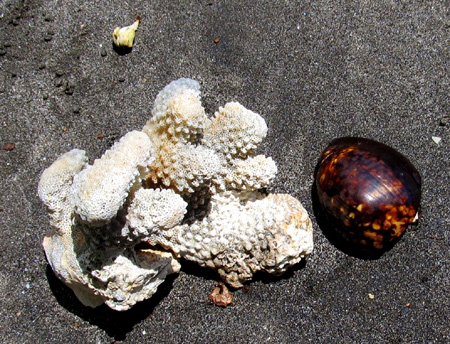
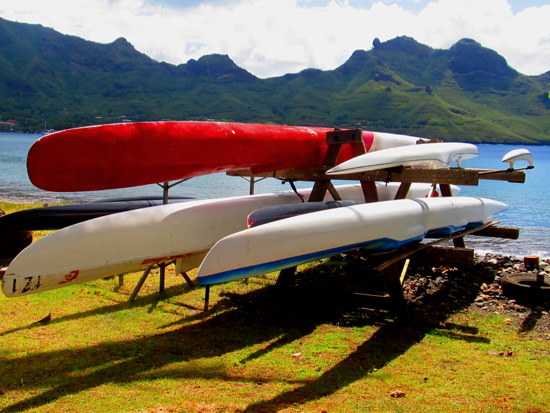
Some outrigger canoes.

We were pretty much alone on the beach for a while.
 
The white sand from the wearing down of the coral creates
interesting shapes as it washes on top of the dark, volcanic
sand.

 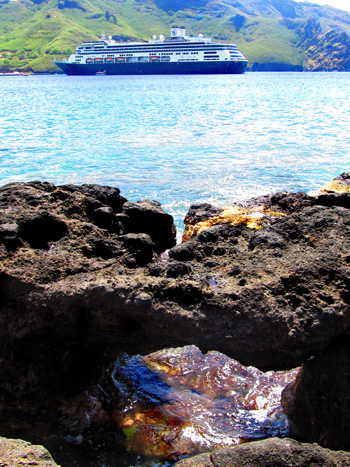
A couple of tethered horses not far from the beach mow the roadside
grasses. The Amsterdam is above a small land bridge from this
vantage point.

This rock is an island at high tide, but not at low tide.
 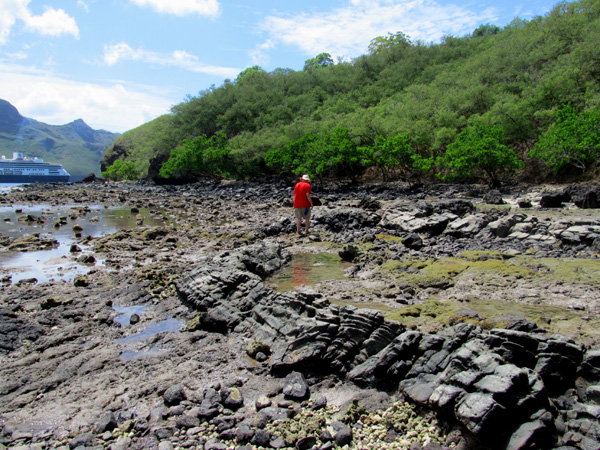
A lava vein cuts across the the rock and out on the beach, which is
much rockier out here.
 
We saw a profile of a young girl or an old man in the cliff. A
beautiful shell...
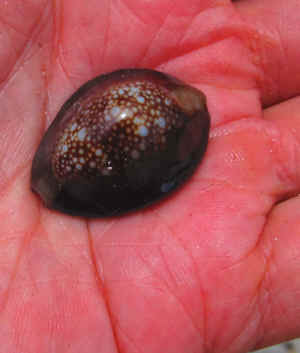 
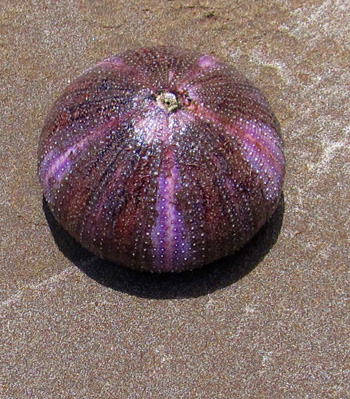
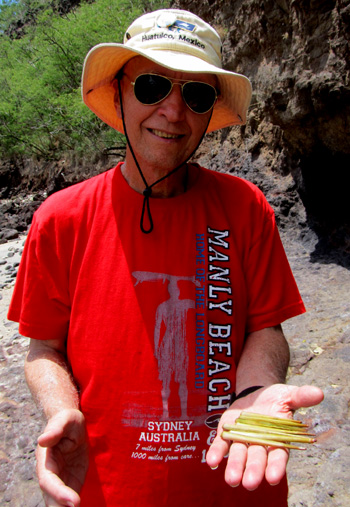
A spiny urchin and a bunch of pencil urchin spines that Dean found
on the beach.


The weathered and lichen-covered cross indicates the church
road.


A graceful arched stone wall serves as the entrance to the church
yard. The peaked shelter protects a sculpture of a pope.
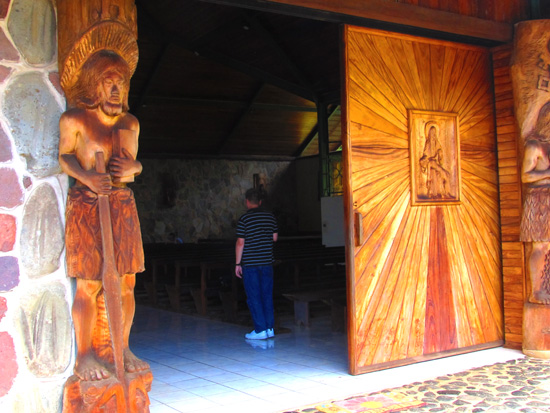 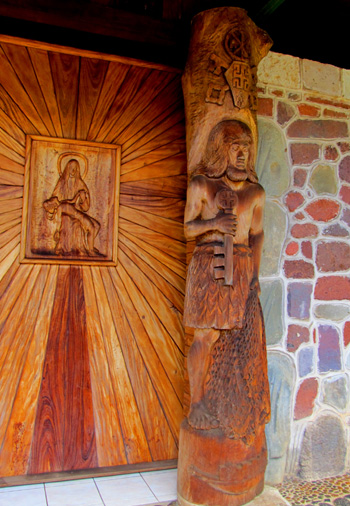
Isn't it interesting that Jesus as depicted here looks like the
natives—complete with a grass/leaf lava-lava (skirt).

 
The carved pulpit and the Madonna are part of this hand-crafted
church.
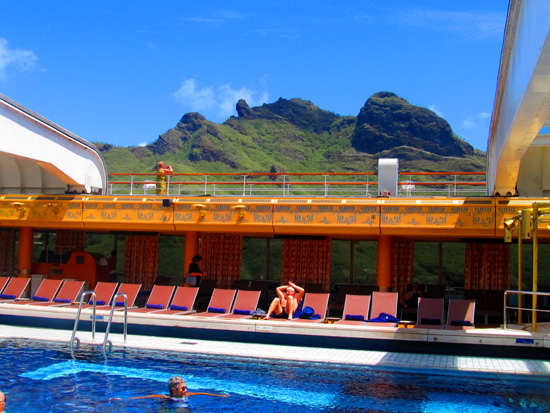
After a couple of hours on the Internet near the tender dock, we
boarded the ship for the sail away.

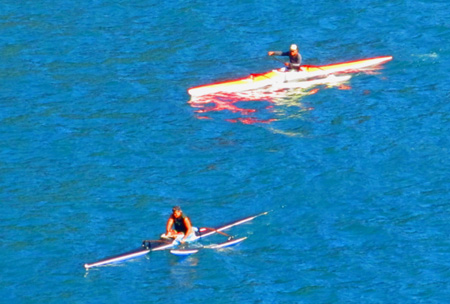
The locals on their out-rigger canoes caught rides on the wakes the ship's tenders and there were several
waiting to escort us
out of the harbor. Dean's
log: Nuku Hiva.
~ ~ ~
It took a day at sea as we sailed out of the Marquesas
Islands and to The Society Islands and into
Pape'ete, Tahiti. We were there on the 2012
cruise, so see that page for details on the town, but we found
some different sites this time around, which was a Saturday and a
Sunday. (Itinerary)
 
The buses don't run on Sunday so we took one when we got into port.
This little girl was traveling with her grandmother, mother,
and new sibling.
 
After taking the bus back, we saw the 3-man out-rigger canoe near
the ship. Then we walked along a very nice waterfront park. A local
boy was playing an 8-string ukulele, which is sorta like a 12-string
guitar where there are 2 strings for each position, but are tuned
slightly differently for a richer tone. Here they tune the 2nd string
of each pair to be slightly flat for a French mandolin sound.


There are many more canoes on stands here in the park.


Some boys had fashioned an exercise bar between 2 palms in the park.
This monument is in celebration of Tahiti's 30 years of autonomy
from France—1984 to 2014.
|
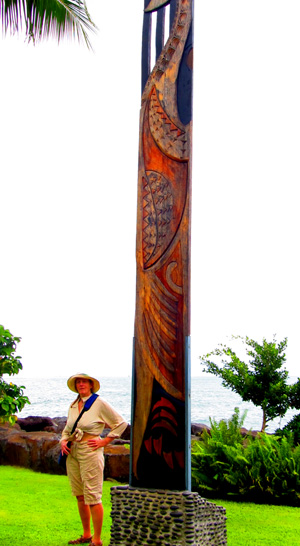
This monument was near the end of the waterfront park. We
continued walking and found these boys surfing at a mouth of a
small river where the waves were breaking right into the rock
jetties.
|

|
|

We'd seen these colorful birds here last time and in our
various Hawaiian trips.
|


An interesting logo adorns the side of a building and some laundry
hung to dry on a balcony.

As we crossed the bridge over the river we saw the surfers from a
different angle.


We liked the pattern built into this rock wall and the graphic on
the side of the swimming pool building that uses iridescent shells
as the bubbles next to the swimmer.


A man was teaching the kids to fish.

We looked back from the fishing lessons toward the boat and caught
yet another view of the surfers including one who was about to be
parted from his board.
 
From there we crossed the street and walked the cemetery.


This stages of life for women and men were carved into either side of
a vault.
 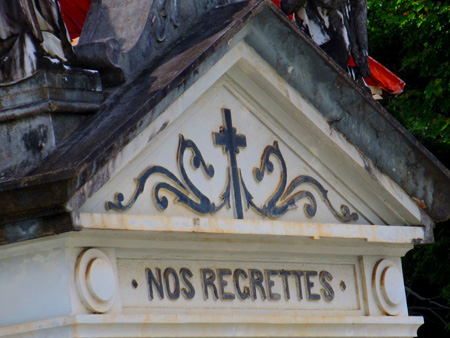
A dove adorned the top of a cross and the saying on this vault
translates to "Our sorrows." We like our translation
better—no regrets.
 
The Polynesian logo includes a representation of the water, the sun,
a 2-hulled war canoe, and the 5 stick figures representing the 5
peoples that make up Polynesia was on the side of a college building.
Nearby we stopped and had a nice conversation with this man who was
taking out the trash for his store. It turns out that there are
several of these stores and Maeva is his daughter.



The logo was on the gate of a government complex, which was closed
for the weekend. A reflective door... And a monument to the unknown
soldier, but we'd never see one with a chicken on top before.
 
We took a photo of the greeters for the Paul Gauguin cruise ship on
the other side of the dock as we came in from our walk. Paul Gauguin
was a French Impressionist painter who spent most of his later life
here on the islands. His tropical scenes sold well in France and
also sold the French people on the paradisical nature of the islands.



A Polynesian feast was served as dinner at poolside that evening.
The watermelon artists are amazing.
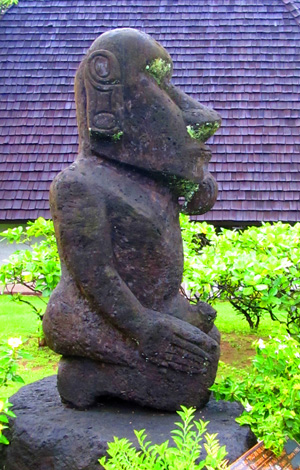
Sunday morning we were out early because we'd heard
that the market was active early on Sundays. We'd been to the
market on the 2012
cruise, so you can check out how much more sedate it was on a
weekday.
We liked this Easter Island-style tiki right next to
the port tourist office with lichen growing in its eyes and
nostrils. See our Easter
Island page from the 2012 voyage for a comparison.
|








